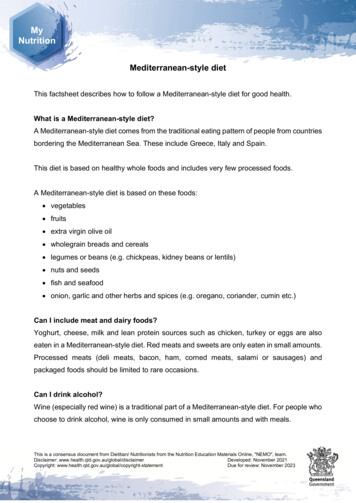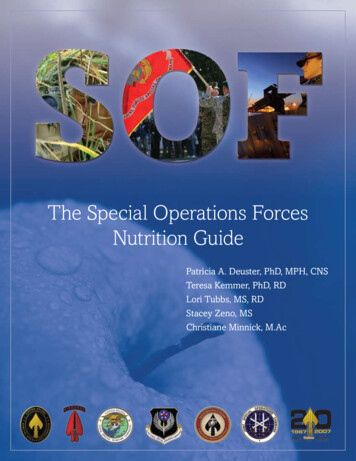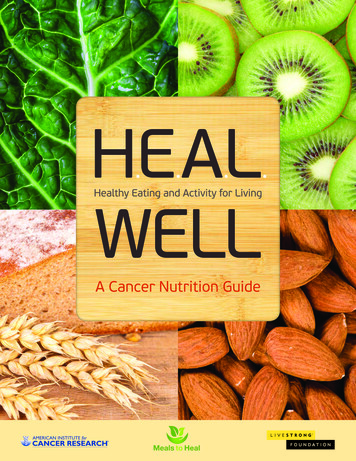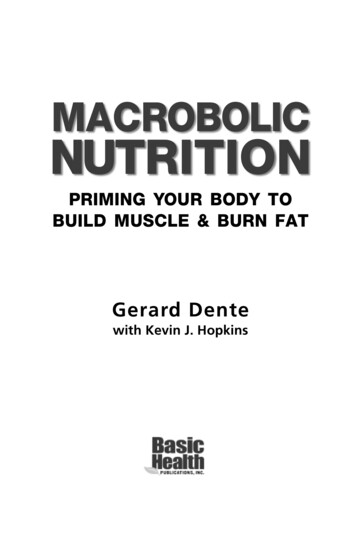
Transcription
MyNutritionMediterranean-style dietThis factsheet describes how to follow a Mediterranean-style diet for good health.What is a Mediterranean-style diet?A Mediterranean-style diet comes from the traditional eating pattern of people from countriesbordering the Mediterranean Sea. These include Greece, Italy and Spain.This diet is based on healthy whole foods and includes very few processed foods.A Mediterranean-style diet is based on these foods: vegetables fruits extra virgin olive oil wholegrain breads and cereals legumes or beans (e.g. chickpeas, kidney beans or lentils) nuts and seeds fish and seafood onion, garlic and other herbs and spices (e.g. oregano, coriander, cumin etc.)Can I include meat and dairy foods?Yoghurt, cheese, milk and lean protein sources such as chicken, turkey or eggs are alsoeaten in a Mediterranean-style diet. Red meats and sweets are only eaten in small amounts.Processed meats (deli meats, bacon, ham, corned meats, salami or sausages) andpackaged foods should be limited to rare occasions.Can I drink alcohol?Wine (especially red wine) is a traditional part of a Mediterranean-style diet. For people whochoose to drink alcohol, wine is only consumed in small amounts and with meals.This is a consensus document from Dietitian/ Nutritionists from the Nutrition Education Materials Online, "NEMO", team.Disclaimer: www.health.qld.gov.au/global/disclaimerDeveloped: November 2021Copyright: e for review: November 2023
Other eating tips in a Mediterranean-style dietFollowing a Mediterranean-style diet is not just about what foods you eat but also about howyou eat them: Try preparing fresh foods Ideally share your meals with friends or family Eat meals and snacks without distractions (e.g. not in front of the TV or at your desk) Eat slowly so that the taste and flavour can be appreciatedWhy is a Mediterranean-style diet healthy?The Mediterranean-style diet is healthy because: it has a good balance of healthy fats it is high in fresh foods and has lower levels of highly processed foods It is high in fibre. This makes the diet filling without providing excess caloriesMyinflammation in the body It is high in antioxidants and can reduceMyNutritionNutritionThese benefits are related to following a Mediterranean-style eating pattern as a whole, notfrom single foods or nutrients.Following a Mediterranean-style diet can help people with: heart disease type 2 diabetes fatty liver disease chronic kidney disease depression or anxietyThis style of eating can also help to prevent people from developing the conditions listedabove, as well as: some cancers, including bowel cancer cognitive decline, including dementiaThis is a consensus document from Dietitian/ Nutritionists from the Nutrition Education Materials Online, "NEMO", team.Disclaimer: www.health.qld.gov.au/global/disclaimerDeveloped: November 2021Copyright: e for review: November 2023
What does Mediterranean-style eating look like?This food pyramid shows the foods and drinks in a Mediterranean-style diet. At the base ofthe pyramid are foods to eat the most. At the top are foods to eat in small amounts or lessoften. Enjoying meals with others and being active is also highlighted. If you have liverdisease it is best to discuss any alcohol intake with your doctor.Mediterranean Diet PyramidLess oftenIn moderationModerate portions,daily to weeklyMyMyNutritionNutritionOften, at least twotimes per weekBase every mealon these foodsThis is a consensus document from Dietitian/ Nutritionists from the Nutrition Education Materials Online, "NEMO", team.Disclaimer: www.health.qld.gov.au/global/disclaimerDeveloped: November 2021Copyright: e for review: November 2023
What and how much should I be eating to follow a Mediterranean-style diet?Food groupServings per day or per weekServing size(1 cup 250 mL measuring cup)Foods to include every dayVegetables1 cup salad or ½ cup cooked /75 g5 serves per day (or more) Includeleafy greens and tomatoes dailyWholegrain breads /cereals / rice / pasta30 g cereal / 1 small wrap / 1slice bread / ½ pita / ½ cupcooked rice or pasta4-6 servings per dayExtra virgin olive oil1 tablespoon / 20 mL2-4 tablespoons per day ChooseAustralian certifiedFruit1 whole piece / 1 cup diced / 1½tablespoons dried2-3 serves per day (2 serves fresh)Water6-8 250 mL glasses per dayShould be the main drinkNuts (unsalted)Foods to include a few times per week1 handful / 30 g3 serves per week (or more)Legumes (canned ordry)1 cup / 150 g3 serves per week (or more)Fish and seafood100-150 gEggs1 egg / 50-60 g4 serves per week (or less)Cheese (feta, ricottaor cottage)2 thick slices / 40 g2-4 serves per weekYoghurt(unsweetened)1 small tub (120-200 g) / ½ cup4-6 serves per weekMilk (unflavoured)1 cup½ -1 serve per dayChicken or turkey100-150 g1-3 serves per weekMyMyNutritionNutrition2 serves per week (or more), at least1 oily (e.g. salmon, tuna or sardines)Foods to include less oftenSweet /savourysnacks30 g chocolate / small packetchips / 2 biscuits3 serves per week (or less)Red Meat (beef, lambor pork)80-100 g / size of deck of cards1 serve per week (or less)Red wine (if youchoose to drink)100 mL / 1 standard drink1-2 glasses per day with meals andno more than 10 per weekThis table is a guide. A Dietitian can help you determine how many serves is right for you.This is a consensus document from Dietitian/ Nutritionists from the Nutrition Education Materials Online, "NEMO", team.Disclaimer: www.health.qld.gov.au/global/disclaimerDeveloped: November 2021Copyright: e for review: November 2023
Mediterranean-style meal and snack IdeasBREAKFAST options Porridge: rolled oats made with milk/water, with fruit, honey and/or nuts Natural Greek style yoghurt with fruit, nuts or untoasted muesli, and honey Wholegrain breakfast cereal (e.g. Weetbix, Vitabrits, All Bran, Sultana Bran) withmilk/yoghurt Toast (wholemeal or multigrain) with extra virgin olive oil and ricotta/cottage/feta cheese ORpoached/boiled/scrambled egg OR grilled tomato and herbs OR baked beansLUNCH options Salad, including tomato and a dark leafy green such as spinach and canned beans orlegumes, with extra virgin olive oil Sandwiches/wraps – wholemeal bread, roll, wrap or pita with salad. Use canned fish,beans, hummus or chicken breast as a filling. Drizzle with extra virgin olive oil Wholemeal pasta with vegetables and extra virgin olive oil or tomato based sauce. Tryreplacing meat with canned lentils or beansDINNER options Vegetable soup, including chickpeas/lentilswith vegetables, canned tomatoes and onion.MyMyvirgin olive oil and mixed herbs with salad Chicken breast: stir-fry, baked or grilledin extraNutritionNutritionor vegetables and wholemeal bread or rice Homemade pizzas, with a wholemeal bread base and drizzled with extra virgin olive oil. Tryvegetable toppings such as onion, eggplant and zucchini Small portion of lean beef, lamb, veal or kangaroo: stir-fry, baked or grilled in extra virginolive oil with salad or vegetables and canned beans/lentils. Optional extra: 1 small glass of red wine with your mealSNACKS Handful of nuts and/or seeds Fruit (fresh, canned or dried) Fresh vegetable sticks with hummus or tzatziki Natural Greek style yoghurt Wholemeal crusty bread dipped in extra virgin olive oil/pesto Avocado on toast or wholegrain crackers (with extra virgin olive oil) Boiled egg OR feta/ricotta cheese on a slice of wholemeal bread or crackersAcknowledgement: the included food, meal and snack recommendations were adapted based on materialsdeveloped for the LIFE, MedLey, AUSMED and MEDINA Mediterranean diet research studies in AustraliaThis is a consensus document from Dietitian/ Nutritionists from the Nutrition Education Materials Online, "NEMO", team.Disclaimer: www.health.qld.gov.au/global/disclaimerDeveloped: November 2021Copyright: e for review: November 2023
Putting it all together – Mediterranean-style portions on plateUse extra virginolive oil (replaceother oils andspreads incooking anddressing)¼ of the platewholegraincereals orbread¼ of the platelegumes, fish,poultry or eggsand sometimesred meat½ of the platevegetables orsalad. Include avariety of coloursDon’t forget to snack on fruits,nuts, seeds, and dairy foods.Flavour withherbs and spicesImaged sourced from National Heart Foundation of AustraliaMediterranean-style diet resources including information, research and recipesWebsites:Oldways ean-dietInternational Foundation of Mediterranean diet ranean Living https://www.mediterraneanliving.com/Heart Foundation ucation/healthy-eatingGrains & legumes nutrition council https://www.glnc.org.au/Nuts for life https://www.nutsforlife.com.auBooks:The Mediterranean Diet https://www.panmacmillan.com.au/9781742610825/The Heart Heath Guide heart-health-guide/Mediterranean diet cookbook and lifestyle plans https://treeoflifenutrition.com.au/cookbook/Things I can do to improve my style of diet to be more Mediterranean:1.2.3.This is a consensus document from Dietitian/ Nutritionists from the Nutrition Education Materials Online, "NEMO", team.Disclaimer: www.health.qld.gov.au/global/disclaimerDeveloped: November 2021Copyright: e for review: November 2023
What is a Mediterranean-style diet? A Mediterranean-style diet comes from the traditional eating pattern of people from countries bordering the Mediterranean Sea. These include Greece, Italy and Spain. This diet is based on healthy whole foods and includes very few processed foods. A Mediterranean-style











